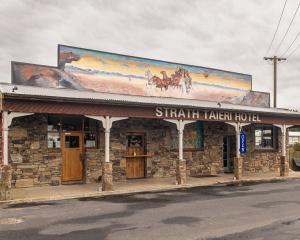It's cold; bitterly so. The moorland looks wild, treacherous and thoroughly uninviting. Any minute now, a gruesome fog could descend, shrouding vicious dogs that have the sole intent of shredding trespassers' legs to strips.
But it wouldn't feel right any other way. Let's face it, Emily Bronte didn't promise balmy sunshine, daisy-filled meadows and jaunty cows ambling through the tulips.
Then again, she didn't promise a reservoir either... We're climbing up towards Ponden Hall, a grand Elizabethan-era farmhouse in the Yorkshire Pennines.
It perches above the water, with views of the moors in every direction. There's nothing else around, barring the odd sheep and dry stone wall.
If the setting evokes memories of Wuthering Heights, then it's for a very good reason. It is widely believed that Emily Bronte used Ponden Hall as the inspiration for Thrushcross Grange, the home of the Linton family and base for the novel's two narrators.
It seems considerably smaller than Bronte describes, and it has clearly seen better days. The only sign of life is the small guesthouse next to it and the odd baa-aaa from the fields.
To get to the inspiration for Wuthering Heights from Ponden Hall, a muddy walk across the moors is required. Bronte wasn't making that bit up either - it's about two-and-a-half miles away over hills and through exceptionally boggy terrain.
Trying it without wellies on is an exercise in masochism. Besides, there's not a lot to actually see up there.
The old farmhouse at Top Withens is now little more than a shell. Over the years, parts of it have been taken away by souvenir hunters and it's now effectively a ruin. Albeit one with great views.
The nearest town to both locations is Haworth, and in terms of British literary destinations, only Stratford-upon-Avon gets more visitors.
Haworth was where the Bronte family lived and the sisters did their writing. Their father was the parson at the local church, and now just about everywhere in town boasts a Bronte connection.
The Black Bull pub was where their black sheep brother Branwell did his heavy drinking, the Apothecary opposite was where he got his drugs and the Rosie Bobbin lace shop is thought to be the old post office from which Charlotte Bronte posted off their manuscripts to be published.
The church that the girl's father, Patrick, was charged with was rebuilt soon after he died. Very little of it remains, but the parsonage that the family lived in still stands. It has now been turned into a museum.
The rooms are kept in keeping with the period - Patrick Bronte's study and the dining room in which the girls did most of their writing have been restored as accurately as possible, for example.
The museum also contains letters and little books written by the Brontes, as well as numerous personal artefacts. These include dresses belonging to Charlotte and the shocking thing is how tiny the sisters were. None reached five foot tall.
According to the museum's director, Andrew McCarthy, visitors come for vastly different reasons. Some are interested in the Brontes' writing, others are interested in their lives.
The latter are arguably even more dramatic and depressing than the former.
The museum tries to explain the conditions that led to Patrick Bronte outliving both his wife and all six of his children; it wasn't the healthiest of times to be living in.
Of the Brontes, Charlotte was the star pupil, and her life is arguably best explored away from Haworth. About three quarters of an hour away is what is being branded as Shirley Country. Shirley was Charlotte's second novel, and it's arguably the most male-friendly in the Bronte canon (think fights, politics and workers' uprisings).
It was set in the area - the Spen Valley - where her influential friend Mary Taylor lived. Oakwell Hall near Batley was used as Fieldhead in the book - ironically it is being used as Wuthering Heights in a new TV version of Emily Bronte's only novel - while the Red House in Gomersal was the inspiration for Briarmans.
The Red House was Mary Taylor's home, and like the Bronte Parsonage, it has been restored to how it would have looked in the period.
Attached is a small (but excellent) exhibition about the book and Charlotte's links to the area. It shows that Charlotte clearly wanted more to life than Haworth could offer, and that the relatively palatial home of the Taylors made a huge impression on her.
It includes pictures of her (she was not exactly an oil painting) and contemporary recollections about her. Mary Taylor recollected that Charlotte had a strong Irish accent when they met at boarding school.
Indeed, it is often forgotten that the Bronte family was Irish - Patrick Brunty changed the surname when he moved over to England.
The exhibition also explores Charlotte's various romances and what life was like for middle class women in her day - there weren't many options aside from marrying rich or becoming a governess.
Most interesting of all is the way the books were received at the time. In the mid 19th century, the likes of Jane Eyre and Wuthering Heights were considered somewhat racy and brutal. Charlotte originally had the books of all three sisters published under the names of Currer, Ellis and Acton Bell.
When the secret got out, it caused quite a stir. After all, if the Yorke Family in Shirley was clearly the Taylors, then who else featured in these scandalous books which generations have grown to love?
IF YOU GO:
Haworth (www.haworth-village.org.uk) is in West Yorkshire, around an hour away from Manchester airport and lies to the west of Bradford.
Shirley Country is to the south of Bradford. The Bronte Parsonage (www.bronte.org.uk), Oakwell Hall (www.friendsofoakwellhall.org.uk) and the Red House are all open to visitors. Visiting hours can be limited, so check ahead.
For more details on the region, visit www.yorkshire.com.












